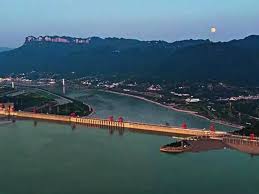NEW DELHI: China on Tuesday reiterated its stance to build the world’s largest hydropower dam upstream of Brahmaputra close to the Indian border, while assuring “help” to downstream countries, including India and Bangladesh, with “disaster prevention and reduction and climate response”.
Chinese spokesperson Yu Jing said Beijing’s decision to build the project in the lower reaches of the Yarlung Tsangpo (as Brahmaputra is called in China) had been made after “rigorous scientific evaluation” and “will not have a negative impact on the ecological environment, geological conditions and the rights and interests related to water resources of downstream countries”.
Planet Earth’s “biggest infra project”
The dam is what is being called the planet’s largest infrastructure project, “larger than any other single infrastructure project in the world including the Three Gorges Dam in China”.
State-run Xinhua news agency was quoted as saying that on December 25, 2024, the Chinese government approved the construction of the hydropower project in the lower reaches of the Yarlung Zangb—the Tibetan name for the Brahmaputra.
On completion the 60,000 MW project will have the capacity to produce three times the amount of electricity Three Gorges Dam on the Yangtze produces. The total investment in the project is expected to exceed one trillion yuan ($137 billion).
With a vertical drop of 2,000 metres over a 50-km distance, the location is said to be one of the most hydropower-rich areas in the world.
To harness the hydropower, massive structures will be built, including tunnels through mountains, as per reports.
Why is India concerned
The location is close to the Indian border and there are bound to be worries and concerns.
Riparian countries India and Bangladesh have both raised concerns
Water is precious and a cause of major disputes within a country let alone between two nations which don’t see eye to eye on many issues, including borders and water-sharing.
After the dam has been built, China would not only be able to control the water flow, the fear is that the size and scale of the project will also enable it to release large quantities, especially in the times of hostilities.
Then there are also these very real fears of possible damage to the environment and ecology.
The project site is located along a tectonic plate boundary where earthquakes frequently occur, say detractors, adding that building a dam of this magnitude is bound to do more harm than good.
In fact, today (January 7) a powerful earthquake — measuring 7.1 on the Richter scale — in the Shigatse region of Tibet, claimed lives, shaking buildings in many areas in India’s Delhi, Bihar, West Bengal and even Assam, and also neighbouring Nepal and Bhutan.
Though reports quoting officials say that the hydropower project is safe and prioritises ecological protection.
“Through extensive geological explorations and technical advancements, a solid foundation has been laid for the science-based, secure, and high-quality development of the project,” they say.
The green project aims at promoting low-carbon development. By harnessing the abundant hydropower resources, the project will spur the development of solar and wind energy resources and create a clean energy base for hydro, wind and solar power, they add.
Amid China’s move to dam the river in Tibet, India is also building a dam over Brahmaputra in Arunachal Pradesh.
The proposed project is expected to help in ensuring water security and mitigating floods.
The mighty Brahmaputra
Called Yarlung Tsangpo in China, Brahmaputra is one of the longest rivers in the world.
From Tibet it enters Arunachal Pradesh where it is known as the Siang.
In Assam, it is joined by tributaries and becomes the Brahmaputra.
The mighty river then enters Bangladesh and empties into the Bay of Bengal.
It is a lifeline for those living on its banks.
People use it as a source for drinking water, irrigation, fisheries and inland transport.
The river also deposits huge quantities of fertile alluvial soil suitable for agriculture.
However, due to geographical and climatic conditions, it also causes periodic floods in Assam and Bangladesh.
India-China water sharing
Trans-border rivers flowing from China to India fall into two main groups.
One, the Brahmaputra river system on the eastern side consists of river Siang (main stream of river Brahmaputra) and tributaries Subansiri and Lohit.
Brahmaputra is called Yaluzangbu or Tsangpo in China.
Second is the Indus river system on the western side consists of river Indus and the river Sutlej. There are two MoUs for the provision of hydrological information on these two rivers by China to India.
An Expert Level Mechanism (ELM) also exists between India and China to discuss issues related to trans-border rivers.
The ELM was set up in 2006 to discuss interaction and cooperation on provision of flood season hydrological data, emergency management and other issues regarding trans-border rivers as agreed between them. Accordingly, the two sides set up the Joint Expert Level Mechanism through a Joint Declaration, according to the government.
The ELM meetings are held alternately in India and China every year.
The 14th meeting of ELM was held at New Delhi in June, 2023.
Data sharing of trans-border rivers also figured in the recent talks between India, China Special Representatives (SRs) for border questions.
“The SRs exchanged views on bilateral, regional and global issues of mutual interest. They provided positive directions for cross-border cooperation and exchanges including resumption of the Kailash Mansarovar Yatra, data sharing on trans-border rivers and border trade. They agreed on the salience of stable, predictable and amicable India-China relations for regional and global peace and prosperity,” according to the December 18 statement by the Ministry of External Affairs.


